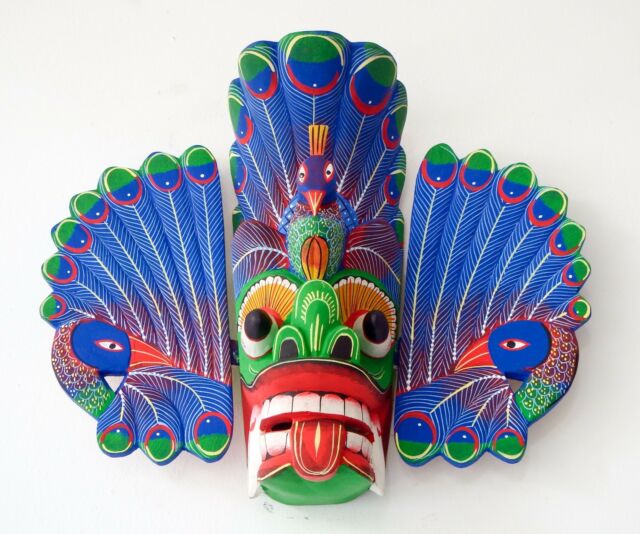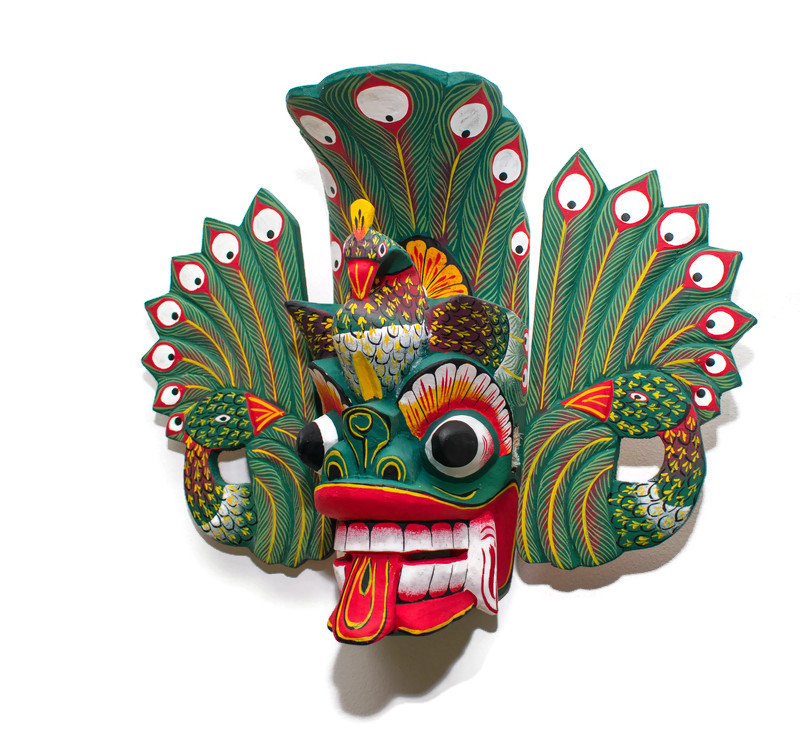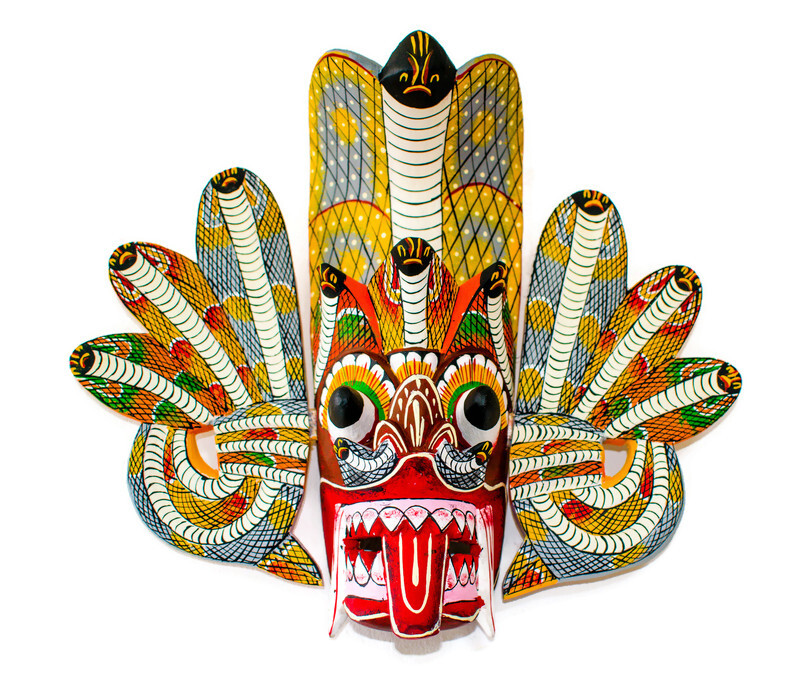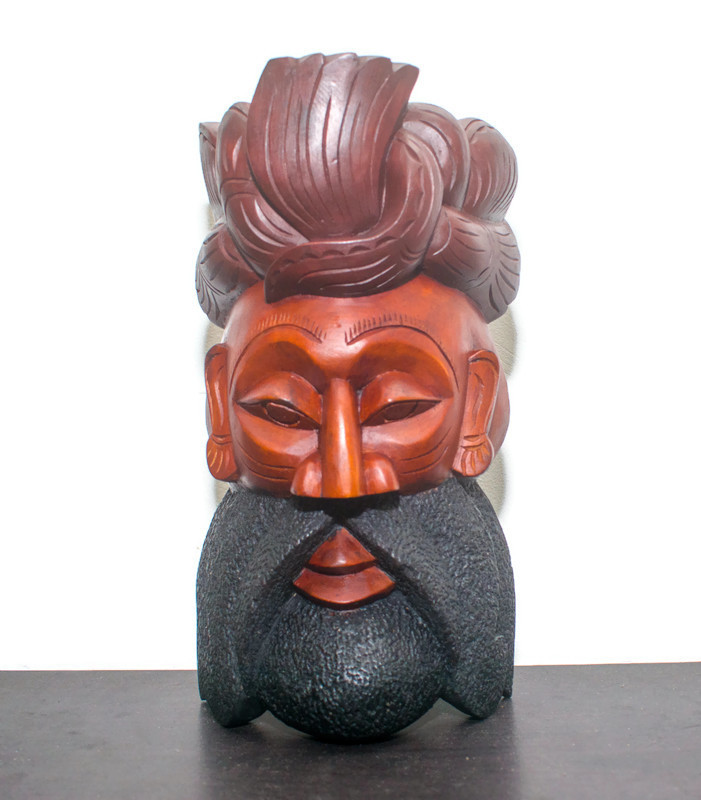|
Mystery of the Sri Lankan Masks
|
|
|
'Ves' in Sinhala means to disguise. We talk of 'ves marukaranawa' to indicate disguise. 'Ves gannawa', means to dress up and we often refer to a person changing his attitude in terms of 'ves peralenawa'. The 'ves natuma' is a form of Kandyan dancing and the 'ves muhuna' is a mask which is worn over the face of a dancer or an actor. The idea in wearing a mask is to hide your real identity. You then project a different character or personality. The mask is used in ritual or dance drama to transform the wearer into a specific character. It sends out a multi-faceted effect visually, theatrically and symbolically. Masks are used extensively in ritualistic performances. 'Thovil' is a common form of ritual dancing in rural Sri Lanka performed mainly to seek redress from illnesses or to ward off evil spirits. There is the common belief that certain ailments are caused by unseen hands and that they should be chased away for the patient to get cured. If an individual or a family is not doing well, the village-folk believe that it's because that person or the family is being harassed by unseen hands. A 'thovil' ceremony is the answer. The 'thovil' can be a simple ritualistic ceremony at home restricted to family and immediate neighbours or involving the whole village like the 'gam-maduva' or the 'devol-maduva' which is closely linked to the worship of gods. Masked dancers take part in at least two of the well-known 'thovil' ceremonies referred to as the 'Maha Sohon Samayama' and the 'Gara Yakuma'. The mention of 'Moha Sohona' frightens the people since he is believed to be the demon of the graveyards. The performer disguises himself as a bear and wears a mask and a dress to resemble one. Often the 'thovil' involves the 'sanni' dances where all the dancers wear masks. The 'daha ata sanniya' refers to sixteen ailments with a demon being responsible for each one of them. Dancers wearing masks take part in processions while at certain ceremonies, masks are used to depict different characters. Of later origin are the masks worn by children and teenagers at street performances during Vesak. Popularly known as 'olu bakko' for the simple reason that oversize masks are worn, these performances keep the younger-folk, in particular, entertained. Then there are the dance-dramas which have developed in their own style in different parts of the country. The use of masks is common in these, particularly in the 'kolam', the popular dance-drama tradition in the South of Sri Lanka. Referring to 'kolam' as 'masked plays', which survive to this day chiefly in the coastal townships like Mirissa, Ambalangoda and Bentara, Professor Ediriweera Sarachchandra has written that they are chiefly distinguished by the fact that the actors wear masks that are elaborately carved out of some kind of light wood and painted in bright colours. Dr. Sarachchandra lists over fifty characters in his 'Folk Drama on Ceylon' who are presented in a 'kolam'. Starting from the crier (anabera kolama), the soldier (heva rala), the aratchi (aratchi kolama) and the mudaliyar (mudali kolama) the list proceeds in the order the characters are presented. These characters are identified by the masks they wear. In his in-depth study of masks, Professor M. H. Goonatilleka says that Kolam masks represent character types or specific personalities whose distinctive features are portrayed or exaggerated by means of carving and painting of characterizing details and iconographic elements. According to him, the mask is not a static object or an immobile, three-dimensional representation. It is always in movement and is only fully meaningful in the dynamic context of the dance and the dance-drama. Dividing the kolam masks into three, Prof. Goonatilleka categorises them as human, supernatural and animal. Human masks may either be straightforward or caricatures. Masks of gods, goddesses and other mythological figures belong to the category of supernatural masks which include demon masks as well. Animal masks are basically straightforward. Human masks include the royal masks as well as officials like the ministers, the mudliyar, the village headman and the policeman. Then there are a host of others like the chettiar (trader), the Tamil man, the laundry-man, the drummer and his wife Nonchi, and Lenchina, Jasaya's wife in the popular folk tale, bringing a touch of humour to the story. The masks which are made from light wood like 'kaduru' or 'ruk attana' to ensure that they are not heavy at all, are designed to bring out the facial features of the different characters. The mudali and the headman, for example, are proud officials who like to show their authority. They belong to a higher caste and the villages are scared of them. The masks worn by these characters would display features that indicate their positions of authority. In contrast, there would be the 'gama raala' and the 'gama mahage', simple village folk who would wear masks to suit their characters. Beards, moustaches and side burns indicate the social status of the different characters. The supernatural masks belong to two categories – legendary figures of a basically human type and those of demons. These masks are much more elaborate than the human masks, particularly those of female characters. The 'nari-lata', for example, is a very ornate-looking mask with a floral creeper headdress. A bare-breasted figure emerges from the foliage which also forms her skirt. The demonic masks too have elaborate headdresses and large ear-pieces. Cobras in different patterns and positions are a marked feature in these. Animal masks, particularly the bear and the leopard, are used in ritual ceremonies to represent demonic characters. The lion, the crocodile, the fox and the bull are among the other animal masks. Sokari is a folk dance form confined to the hill country performed on the 'kamata' (threshing floor). Sarachchandra says that the play serves no purpose except that of entertainment. A few actors use masks which are much smaller and less elaborate than kolam masks. These are traditionally made from the leaf of the 'kolon' tree or the leaf sheath of the arecanut palm. The mask is an artistic creation used to portray characters – both realistic and mythical. They are very much part of Sri Lankan heritage and should be preserved for the future.
|
Mystery of the Sri Lankan Masks
- Details
- Written by Manoj
- Category: General
- Hits: 5159
In 2024, gamblers in Austria can enjoy safe and convenient online casinos that accept Google Pay. This modern payment system allows you to quickly and easily top up your gambling account without revealing personal data. The page https://allinx.eu/de-at/casino-mit-google-pay/presents the rating of the best legal gambling establishments in the country, where it is possible to use Google Pay for making deposits and withdrawing winnings. Visiting this resource, players get access to reliable platforms, carefully checked for compliance with legislative norms and high security standards. Each casino on the list has undergone rigorous testing, ensuring fair play and quick winnings. Google Pay, on the other hand, guarantees instant transactions, allowing you to focus on the gameplay without unnecessary delays. Choosing an online casino that supports this payment system opens up new horizons for players in the world of gambling. A high degree of security and ease of use make this payment method ideal for modern users. Choosing one of the casinos on the list, you can be confident in the safety of their financial transactions and the integrity of the gaming process.

























































